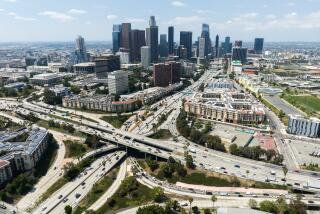First-Class Grass
- Share via
A new playing field awaits opening day at Dodger Stadium on April 8. A state-of-the-art, computer-monitored turf system will make for higher quality grass, truer bounces of the ball and more efficient use of water. Prescription Athletic Turf, by the Motz Group of Cincinnati, uses underground irrigation. A two-inch layer of water is constantly maintained below a foot-thick layer of sand on which the playing grass is laid. This closed-irrigation system maintains the turf’s optimal moisture level, allowing consistent growth all summer regardless of weather or the amount of use.
To install the system, the entire field was dug up and lowered. A waterproof plastic liner was laid down, creating a bathtub-like basin under the field. A grid of perforated polyethylene pipe was installed on top of the liner. Then a thick blanket of sand was poured in and leveled with laser-guided equipment, and the Bermuda turf laid down on top.
The resulting field is more lush than the old grass, more level and 12 inches lower. Water use is far more efficient, delivering moisture directly to the roots. And in the unlikely event of rain, drainage is enhanced. Overhead watering will be used only to keep turf from wilting on hot days, mix in fertilizer and wash off the grass blades.
COMPUTER IN THE BULLPEN
Grid at left shows the layout of plastic piping that supplies the sub-irrigation system. The field is divided into three zones that drain to main lines down the right field line, connecting to a computerized control center in the bullpen. Gauges buried in the field send moisture level data to the computer. Head groundskeeper Al Meyers can release more water to a zone on dry days or remove it on wetter days. Adjustments can also be made through a computer link with the Motz Group in Cincinnati.
FLAT vs. CROWNED
Except for a 2 1/2-inch crown on the infield, the new field is completely flat. (Laser-guided grading guarantees flatness to within 1/2 inch across 2 1/2 acres.) The grass area has been lowered 12 inches and the warning track raised, requiring one step to be added at the dugouts.
The old warning track used to slope down toward the fences, particularly between home plate and the backstop.
The new field will be flat with a slight slope up near the outfield fence and down behind home plate.
LIQUID FOUNDATION
Side-view cutaway shows how the layers stack up. The new system uses 7,000 tons of sand, 70,000 gallons of water, 18,000 linear feet of polyethylene pipe and 130,000 square feet of plastic sheeting.
A FASTER FIELD
Maintaining the old turf became difficult as the original system deteriorated. During summer, rye grass had to be sown in with the existing Bermuda, resulting in some areas of the field having deeper and thicker grass than others. The new system will allow for a consistent growth of turf across the field. Some benefits:
* Steady footing
With a smooth, even field, fielders will be able to run after balls without worrying about their footing.
* Shorter grass
The new turf will be kept shorter, allowing balls to move across the field faster and more consistently.
* Truer bounces
Since the field is flat and the grass short and without thick and thin spots, fielders should be able to judge bounces better.
Sources: Los Angeles Dodgers; the Motz Group
More to Read
Go beyond the scoreboard
Get the latest on L.A.'s teams in the daily Sports Report newsletter.
You may occasionally receive promotional content from the Los Angeles Times.










